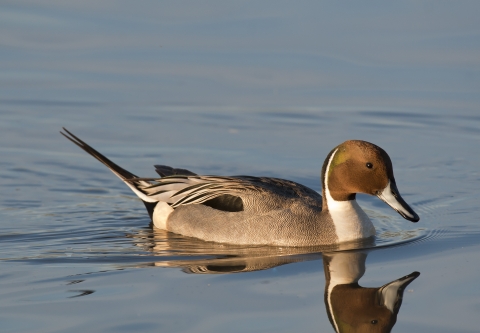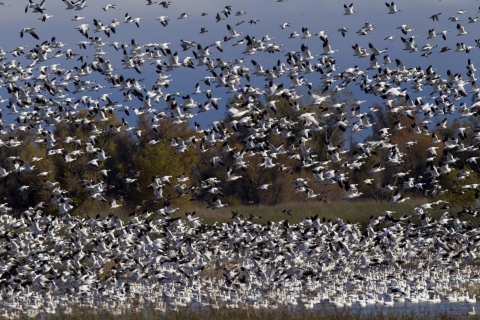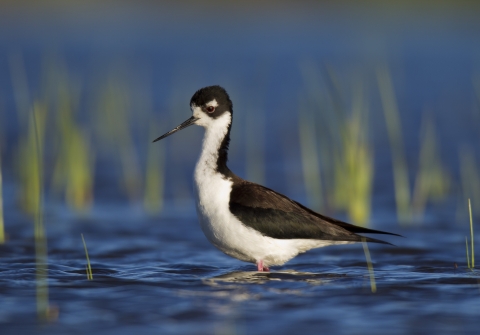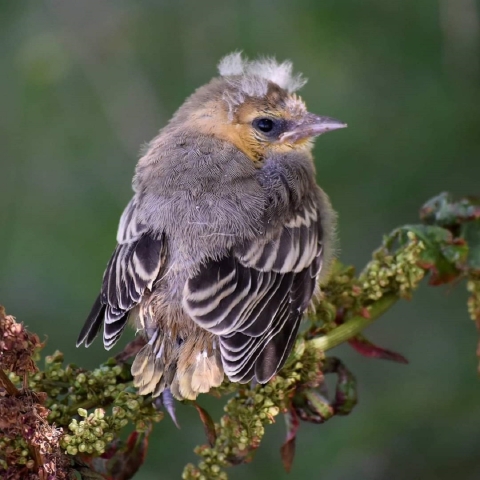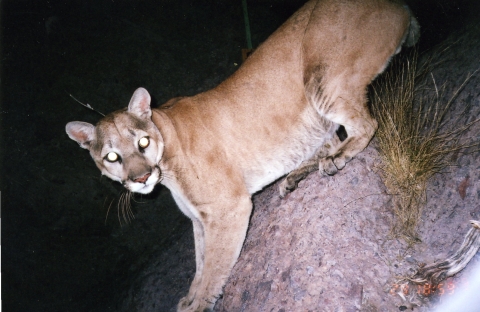Seasons of Wildlife
Sutter National Wildlife Refuge regularly supports peak wintering populations of over 150,000 ducks and 70,000 geese. The mixed riparian riparian
Definition of riparian habitat or riparian areas.
Learn more about riparian forest habitat on the refuge is also important for breeding and migrating passerine birds, and supports a large heron/egret rookery. Sutter NWR is part of the Sacramento National Wildlife Refuge Complex, which provides nearly 70,000 acres of wetland, grassland, and riparian habitats for a wide array of waterfowl, shorebirds, raptors, waterbirds, songbirds, reptiles, and mammals. The Complex currently supports nearly 300 species of birds.
WHAT WE DO <-- Click here to learn more about our HABITATS and HABITAT MANAGEMENT
Wildlife Checklist <-- Click here for our Wildlife Checklist brochure
Each season brings a new look to the refuges with a variety of wildlife. There's always something to see, whether its waterfowl in the winter, shorebirds in the spring/fall, or breeding neotropical migrants in the summer.
Fall (August - October)
Traveling south for the winter, flocks of shorebirds pass through in August and September as the water begins to flow back into the wetlands. Northern pintail are the first ducks to arrive, as early as mid-August, and signal the beginning of fall migration. White-fronted geese will follow in September. White geese (Snow and Ross's) begin to appear in October as fall migration kicks in to full swing.
Winter (November - February)
As the northern breeding grounds begin to freeze, large numbers of green-winged teal, American wigeon, northern shoveler, and American coot arrive in the Sacramento Valley. Joined by gadwall, mallard, bufflehead, and ruddy and ringed-neck ducks, duck and goose numbers peak on the Complex in November and December. In January, birds spread out across the valley as new habitat becomes flooded by winter rains. As February arrives, waterfowl numbers decrease as some begin to migrate north.
Spring (March - May)
As ducks and geese leave for their breeding grounds, shorebirds arrive. Sandpipers, dowitchers, dunlin, avocets, black-necked stilts and others probe the mudflats for food. Vernal pools become a display of colors. The riparian areas of Sacramento River NWR and Sutter NWR are alive with neotropical migrant songbirds.
Summer (June - August)
As the temperature creeps up in the 90's and 100's, most of the water disappears across the refuges. Staff are busy managing the habitats preparing for the next season. Herons, egrets, grebes, and some ducks remain to nest in the riparian trees and permanent ponds. Orioles, swallows, and flycatchers are found amongst the trees. Tricolored blackbird colonies set up in dense cattail territories. Bank swallow colonies can be seen if you float down the Sacramento River, their tiny burrows in the steep sandy banks buzzing with activity. Resident deer, blackbirds, jackrabbits, otters and western pond turtles are common sightings.
_____________________________________________________
Recent Sightings
What wildlife have visitors and staff been seeing on the Complex? We encourage visitors to report to us any sightings of rare, unusual, or unique animals on our refuges and the surrounding areas. Check out the most recent sightings on eBird.
_____________________________________________________
Waterfowl Surveys
Refuge biologists conduct monthly waterfowl surveys.
Click on Waterfowl Surveys to view the Complex's Waterfowl Surveys.
How are surveys conducted?
Wildlife surveys are conducted once a month, mid-month, on all wetland refuges of the Sacramento NWR Complex. All waterfowl, shorebirds, water birds, gamebirds, raptors, and a handful of mammals and other songbirds are tallied on every single unit (pond/field), using a standardized survey route, a window-mounted spotting scope and binoculars. Using the same observer for each refuge helps maintain consistency (some of the biologists have maintained their routes for over 20 years), assuring a strong index over time.
Routes are designed to take advantage of vegetation barriers, viewing lanes, and flight patterns to maximize viewing, reduce disturbance, and increase the likelihood that flushed birds will fly to an area that the observer has already counted. The observer approaches each pond and takes an initial count. When numbers per pond are low (in the hundreds), a count of each species is done separately. When numbers per pond are in the thousands, all species except for ducks are counted separately, and then ducks are counted as one group and a species composition is applied to that group (ie 1% mallard, 4% gadwall, 10% shoveler, 20% wigeon, 25% green-wing, 40% pintail). Composition can change even within a pond, as some species such as teal will concentrate in certain areas, so multiple groups may be counted and described with different compositions across a single pond.
Depending on flock size, birds may be counted as singles, or in groups of 5, 10, 20, 50, 100, or even 1000 (the only option when a group of 20,000 birds take flight). The smaller the grouping that the observer uses for counting, the higher the accuracy.
Each pond/field is scanned from multiple viewing points, with the goal of seeing and counting all visible wildlife. Auditory cues can also be used, especially for secretive marsh birds such as rails or bitterns.
Following a survey week, biologists transcribe their data and enter it into a database. This data is then used to analyze bird use of each pond/field, and can be tied to management data to assess the effectiveness of past treatments, or identify the need for future efforts. It helps managers identify units that are critical for supporting wintering waterfowl, breeding birds, or special status species, which in turn guides decisions when facing drought, water restrictions, invasive species invasive species
An invasive species is any plant or animal that has spread or been introduced into a new area where they are, or could, cause harm to the environment, economy, or human, animal, or plant health. Their unwelcome presence can destroy ecosystems and cost millions of dollars.
Learn more about invasive species or other threats. When rolled up to the refuge level, population trends and distributions over time can be assessed. The data is also pulled to feed into larger survey efforts for a variety of species groups at a statewide level.
_____________________________________________________
Wildlife Depredation Issues?
If you are experiencing problems with wildlife depredation on your private property, you can find information about what you can do by visiting USFWS Migratory Bird website.
_____________________________________________________
Injured or Abandoned Animal?
The refuge does NOT rescue, rehabilitate or accept injured or orphaned animals. If you need assistance, please contact a licensed care facility near you:
- Chico, CA vicinity: Bidwell Wildlife Rehabilitation
- Sacramento, CA vicinity: Wildlife Care Association
- For a statewide list of care facilities, visit the CA Dept of Fish and Wildlife's Wildlife Rehabilitation Facilities webpage.
_____________________________________________________
Mountain Lions
Mountain lions are residents along the Sacramento River, and there are occasionally sightings on Sacramento River NWR, and rarely on the other refuges of Sacramento NWR Complex. Mountain lions tend to be elusive and typically avoid people.
Mountain lions can be found anywhere there are deer. Along the thick riparian habitat of the Sacramento River, mountain lions are often seen. Always be aware of your surrounding.
Report encounters or attacks by calling the California Department of Fish and Wildlife's (CDFW) 24-hour dispatch center (916) 445-0045 and the U.S. Fish and Wildlife Service - Sacramento NWR Complex at (530) 934-2801. In an emergency, call 911.
When visiting, it is highly recommended that you:
- Do not hike, bike, or jog alone. Go in groups.
- Avoid hiking or jogging when mountain lions are most active—dawn, dusk, and at night.
- Keep children close to you. Animals seem especially drawn to children; keep children within sight at all times.
- Do not approach a mountain lion. Most mountain lions will try to avoid confrontation. Give them a way to escape.
- Do not run from a lion. Running may stimulate a mountain lion's instinct to chase.
- Do not crouch down or bend over. A human standing does not resemble a mountain lion's natural prey.
- Fight back if attacked. Mountain lions usually try to bite the head or neck; try to remain standing and face the attacking animal.
- Do all you can to appear larger. Raise your arms. If wearing a jacket, take it off and wave it around. Pick up small children. Wave arms slowly, speak firmly in a loud voice, throw rocks or other objects.
- If a mountain lion attacks a person, immediately call 911.
More information about mountain lions from CDFW. _____________________________________________________
Endangered and Threatened Species
The Sacramento National Wildlife Refuge Complex is home to a number of Federal and State threatened and endangered species. Click here to see a List of Threatened and Endangered Species that occur here.
